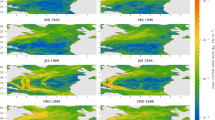Abstract
The sea surface emissivity in the infrared region is determined on the basis of data analyses. Net radiation, surface irradiance and other oceanographical and meteorological variables are measured throughout most of the year at the oceanographical observatory tower in Tanabe Bay, Japan. We have found that 0.984±0.004 is a reliable emissivity value from the night time data. Surface emission radiates not from the subsurface water but from the sea surface. The thermal skin layer on the sea surface, however, is disturbed and disappears under high wind speed over 5 m/s through the analyses of the radiation observation using the emissivity value of 0.984. Under low wind speed, the sea surface can be cooler or warmer than the subsurface due to overlying thermal conditions and the skin layer can be neutral as the transient process between them. By using an emissivity value of 0.984, the temperature difference between the sea surface temperature and the temperature determined from surface irradiance that has been reported in the satellite data analyses is found to be reduced by half.
Similar content being viewed by others
References
Buettner, K. J. K., and C. D. Kern (1965): The determination of infrared emissivities of terrestrial surfaces.J. Geophys. Res.,70, 1329–1337.
Csanady, G. T. (1990): The role of breaking wavelets in air-sea gas transfer.J. Geophys. Res.,95, 749–759.
Davies, J. A., P. J. Robinson and M. Nunez (1971): Field determination of surface emissivity and temperature for Lake Ontario.J. Appl. Meteor.,10, 811–819.
Ebuchi, N., H. Kawamura and Y. Toba (1993): Bursting phenomena in the turbulent boundary layer beneath the laboratory wind-wave surface. p. 263–276. InNatural Physical Sources of Underwater Sound, ed. by B. R. Kerman, Kluwer Academic Publisher.
Grassl, H. (1976): The dependence of the measured cool skin of the ocean on wind stress and total heat flux.Boundary-Layer Meteor.,10, 465–474.
Hasse, L. (1963): On the cooling of the sea surface by evaporation and heat exchange.Tellus,15, 363–366.
Hasse, L. (1971): The sea surface temperature deviation and the heat flow at the sea-air interface.Boundary-Layer Meteor.,1, 368–379.
Katsaros, K. B. (1980): The Aquaous thermal boundary layer.Boundary-Layer Meteorol.,18, 107–127.
Liu, W.-Y., R. T. Field, R. G. Gantt and V. Klemas (1987): Measurement of the surface emissivity of turbid waters. Remote Sens. Environ.,21, 97–109.
Masuda, K., T. Takashima and Y. Takayama (1988): Emissivity of pure and sea waters for the model sea surface in the infrared window regions.Remote Sens. Environ.,24, 313–329.
McAlister, E. D. and W. McLeish (1969): Heat transfer in the top millimeter of the ocean.J. Geophys. Res.,74, 3408–3414.
McMillin, L. M. (1975): Estimation of sea surface temperatures from two infrared window measurements with different absorption.J. Geophys. Res.,80, 5113–5117.
Mikhaylov, B. A. and V. M. Zolotarev (1970): Emissivity of liquid water.Atmos. Oceanic Phys.,6, 52.
Paulson, C. A. and J. J. Simpson (1981): The temperature difference across the cool skin of the ocean.J. Geophys. Res.,86, 11044–11054.
Saunders, P. M. (1967a): The temperature at the ocean-air interface.J. Atmos. Sci.,24, 269–273.
Saunders, P. M. (1967b): Airial measurement of the sea surface temperature in the infrared.J. Geophys. Res.,72, 4109–4117.
Saunders, P. M. (1968): Radiance at sea and sky in the infrared window 800–1200 cm−1.J. Opt. Soc. Amer.,58, 645–652.
Saunders, P. M. (1970): Corrections for airborne radiation thermometory.J. Geophys. Res.,36, 7596–7601.
Schluessel, P., W. J. Emery, H. Grassl and T. Mammen (1990): On the bulk-skin temperature difference and its impact on satellite remote sensing of sea surface temperature.J. Geophys. Res.,95, 13341–13356.
Wesely, M. L. (1979): Heat transfer through the thermal skin of a cooling pond with waves.J. Geophys. Res.,84, 3696–3700.
Woodcock, A. H. (1941): Surface cooling and streaming in shallow fresh and salt waters.J. Mar. Res.,4, 153–161.
Author information
Authors and Affiliations
Rights and permissions
About this article
Cite this article
Konda, M., Imasato, N., Nishi, K. et al. Measurement of the sea surface emissivity. J Oceanogr 50, 17–30 (1994). https://doi.org/10.1007/BF02233853
Received:
Revised:
Accepted:
Issue Date:
DOI: https://doi.org/10.1007/BF02233853



